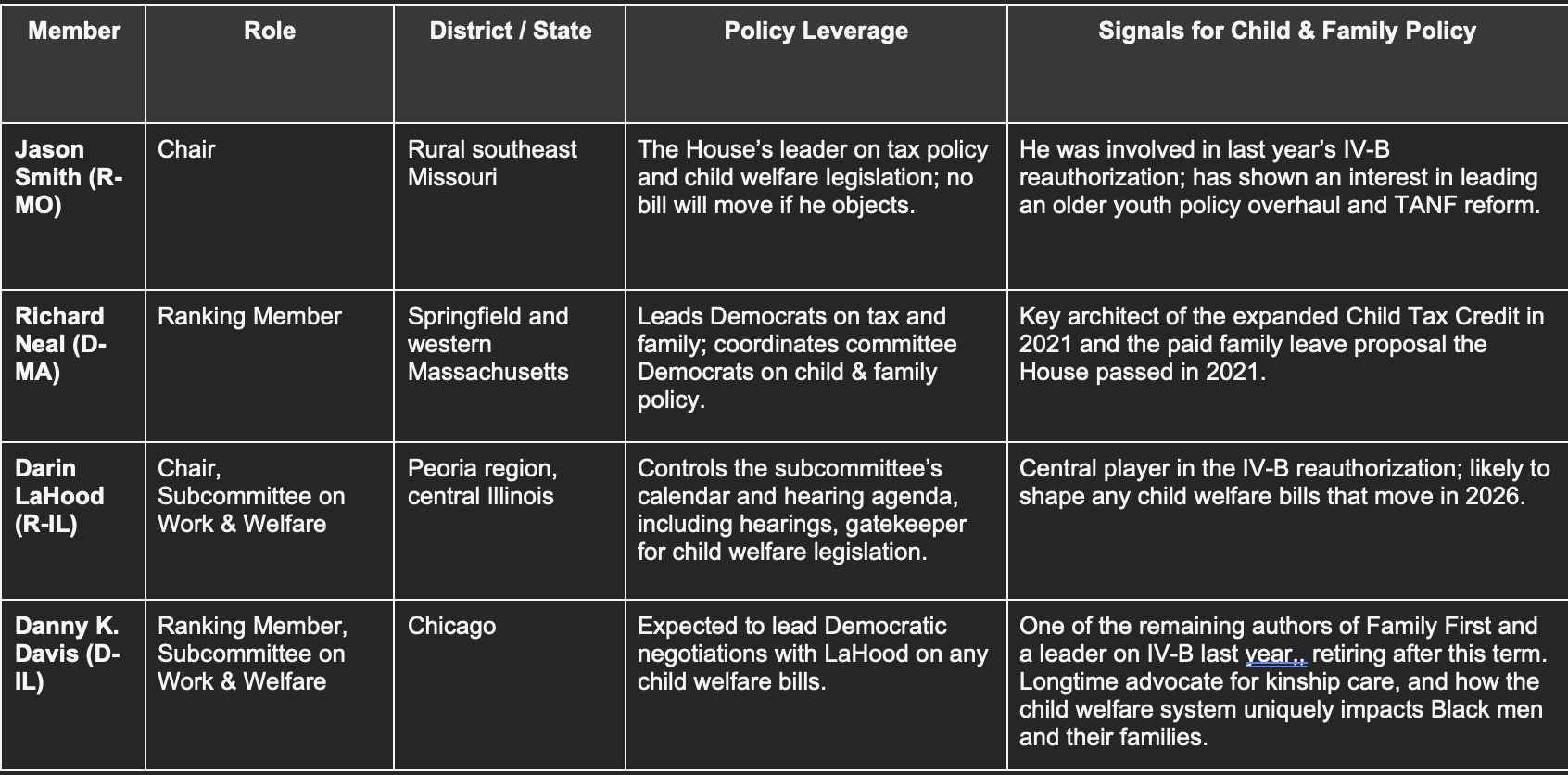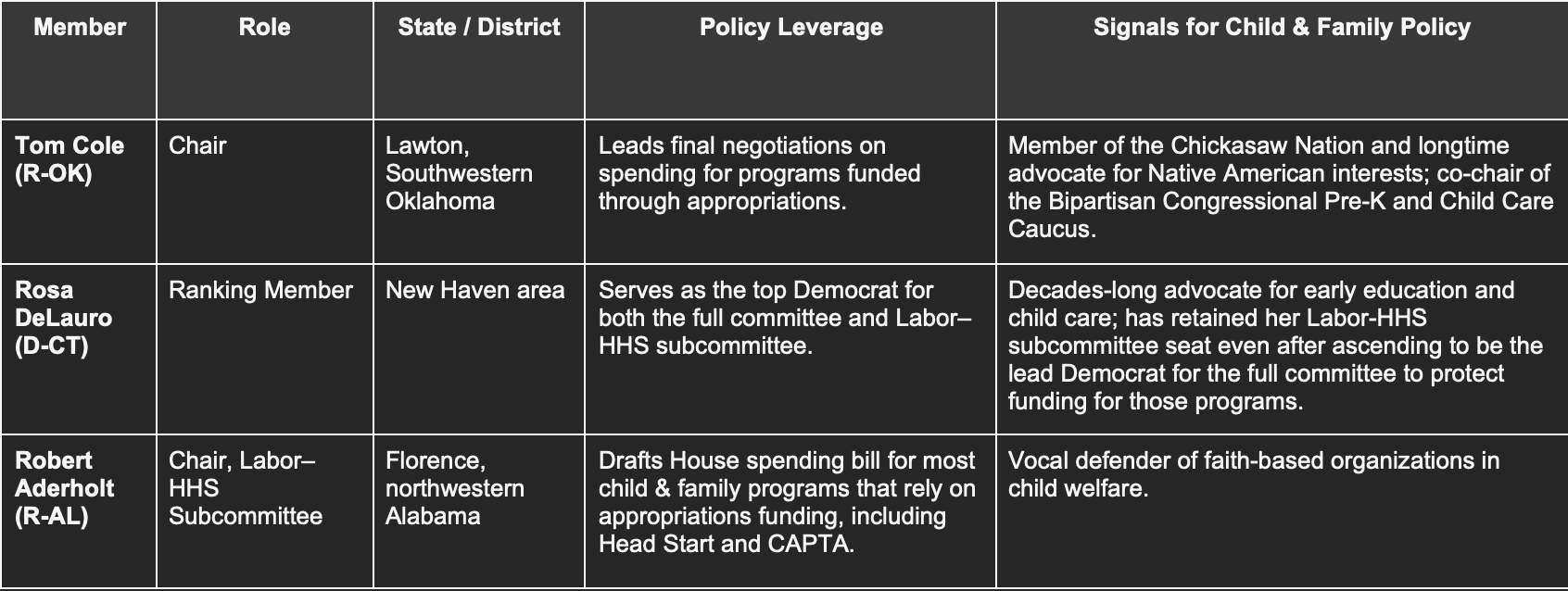Federal Focus: Who’s Who for Child and Family Policy in the 119th Congress
By Doug Steiger, Senior Contributor
Mapping the key formal Congressional power centers to supercharge your strategy.
Child and family policy doesn’t live in one committee, or even one chamber of Congress.
It’s scattered across a maze of subcommittees, budget lines, and personalities that together determine whether programs get funded, stalled, or reshaped.
Understanding that map isn’t inside-baseball—it’s strategy.
These power players control the purse strings, the policy levers, and the processes for deciding what moves for children and families… and what sits on the sidelines.
Where is the Power?
Child and family policy is divided across the architecture of Congress — a structure that ensures no one person, or even one chamber, can move the system alone.
The committees that do the heavy lifting in each chamber control not just funding but policies that direct how and where funds flow and determine how programs for children and families work.
The leaders of these committees are especially important in setting child and family policy. Knowing who oversees which program is crucial to successful advocacy. They have the expertise and the ongoing interest to push through changes, not just chase headlines or social media hits.
The Power Centers
There are four main power centers for child and family policy in the House, and three in the Senate. In the House, we have:
Ways & Means
Appropriations
Education & the Workforce
Energy & Commerce
In the Senate, we have:
Finance
Appropriations
Health, Education, Labor and Pensions (HELP)
House Ways & Means
Ways & Means is where federal child and family policy meets fiscal power. Congress’ oldest committee oversees taxes, child care (mandatory funds), TANF, and much of federal child welfare funding, including Title IV-E.
While tax policy is often the major focus of the committee as a whole, its Work and Welfare Subcommittee handles child welfare and family services.
For anyone working in this space, that’s the venue that determines which ideas reach the floor — and which never even make it to markup.
Senate Finance
The Senate Finance Committee has a similar jurisdiction to Ways & Means– including taxes and Title IV-E– but includes one major additional lever: Medicaid.
Unlike Ways & Means, most work happens at the full committee level, not in subcommittees. That structure allows complex, lower-profile and often bipartisan legislation to advance quietly, worked out behind the scenes – if there are members with the appetite to make the effort.
Senate Appropriations
The Senate Appropriations Committee – in collaboration with its House counterpart – sets the annual funding levels for many major child and family programs, including: Head Start, K-12 education, child care (discretionary funds), housing, WIC, and CAPTA.
Most of this work flows through the Labor-HHS Subcommittee, which funds programs across the Departments of Health and Human Services, Education, and Labor.
Historically, it has worked in a bipartisan manner, though this tradition is under strain from the Trump Administration’s push for greater executive control over government spending.
House Appropriations
The House Appropriations Committee – in collaboration with its Senate counterpart – sets the annual funding levels for many major child and family programs, including: Head Start, K-12 education, child care (discretionary funds), housing, WIC, and CAPTA.
Like Senate Appropriations, delegates much of its work to subcommittees such as Labor-HHS. Historically, it is more partisan than its Senate counterpart, though final appropriations bills involve a bipartisan agreement, giving the House minority a narrow but meaningful role in shaping outcomes.
Senate HELP
The Senate HELP Committee has jurisdiction over the overall policies for Head Start, K-12 education, child care (discretionary funds), and CAPTA. It doesn’t control the money — that’s Appropriations — but it shapes the rules that determine how programs operate.
HELP’s focus traditionally leans toward education and public health, but its reach extends into nearly every system that touches children and families.
House Education & The Workforce
The House Education and the Workforce Committee sets the overall policy direction for Head Start, K-12 education, child care (discretionary funds), and CAPTA.
Unlike its Senate counterpart, it also has jurisdiction over child nutrition programs, such as the National School Lunch Program, giving it added influence over children’s health and poverty outcomes.
While funding totals are ultimately determined by Appropriations, Education & the Workforce defines the policy framework that drives those investments and authorizes the programs themselves.
House Energy and Commerce
The House Energy and Commerce has one of the broadest jurisdiction in Congress, spanning healthcare, technology, and energy.
For child and family policy, its significance lies in that it oversees Medicaid, which insures almost 40 percent of children in the United States.
A few other committees quietly shape the landscape for children and families:
Agriculture (House & Senate) — oversees nutrition programs such as SNAP and WIC, critical to family stability and child health.
Financial Services (House) and Banking (Senate) — oversee housing policy and credit programs that determine whether families can stay housed and solvent.
One should also always keep in mind party leaders as potential players. For example, the House Minority Whip (or #2 House Democrat), Katherine Clark (D-MA), has long been interested in child care policy.
What Decision Makers Need to Know
The loudest members of Congress are often those with the least say in what legislation passes. Real influence lives in jurisdiction — in who holds the gavel, controls the subcommittee calendar, and manages the money.
For state and local leaders, funders, and advocates, understanding that structure isn’t optional. It’s how you anticipate what’s coming, not just react to what passes.






